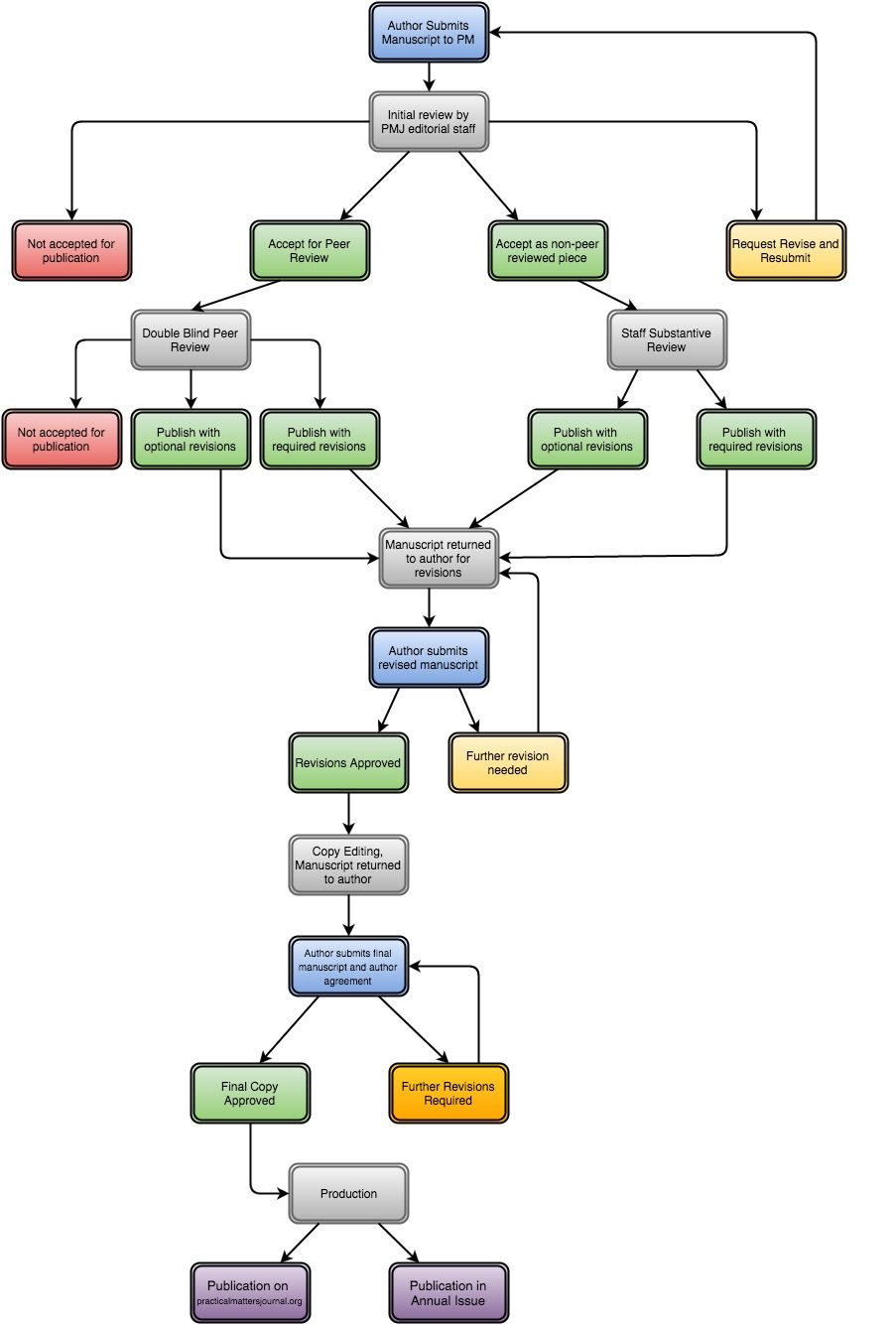Many religious traditions uphold values of justice, community, and belonging, yet many also occupy ambivalent positions vis-à-vis systems and acts of exclusionary violence. Sometimes religion is the target and other times the perpetrator. The study of religious practices has much to offer to conversations on the complex entanglement of religion and exclusion. Similarly, studying religious practices can help us understand how religious communities nurture belonging and work toward personal and collective becoming in more capacious ways. In this issue, we engage critical analysis of the role of exclusionary violence both within and against various religious communities. We also seek dialogue about how communities respond to and resist exclusion with creative processes of becoming and transformation. We invite contributions on and from any religious or spiritual tradition as well as from any theoretical position or discipline. The journal includes both peer-reviewed articles (Features and Analyzing Matters) as well as non-peer reviewed content that presents the thoughtful reflections of teachers and practitioners (Practicing Matters and Teaching Matters). Practical Matters accepts submissions that incorporate a variety of media and genres.Issue 14 Call for Submissions: Exclusion, Belonging, and Becoming in Religious Communities
Deadline: October 1, 2020
Practical Matters is now accepting submissions on religious practices and practical theology for Issue 14. The journal will feature articles on the theme of “Exclusion, Belonging, and Becoming in Religious Communities.” Potential topics may include but are not limited to:
Submissions are accepted and published on a rolling basis throughout the year. For considerations in Issue 14, submissions must be received by October 1, 2020. For more information, please see the submissions guidelines below or email pm.issue.editor@emory.edu.
Download PDF: Issue 14 Call for Submissions
Information for Authors
Aim and Scope of Practical Matters
Practical Matters is a multimedia, online journal interested in submissions that investigate the broad topics of religious practices and practical theology, past or present, in any context or tradition. While each issue features work around a specific theme, we welcome all submissions that promote the dialogue between religious studies and practical theology through scholarship on religious traditions as embodied in religious practices, methods for engaging research questions that emerge in and about religious communities, theories of practice and praxis, and structures of scholarship that allow for more robust interactions between academic institutions and religious practitioners. Submissions from various disciplinary perspectives are encouraged. This includes (but is not limited to) work originating in religious studies, theology, anthropology, literary criticism, cultural studies, sociology, psychology, history, political science, philosophy, media studies, the arts, journalism, or the sciences. We encourage submissions from those both inside and outside the academy as well as work about and from diverse religious traditions.
Audience
Practical Matters has a broad interreligious and interdisciplinary readership. Our audience includes scholars, religious leaders and practitioners, teachers, and students. While typical readers have completed at least some professional or academic education at the undergraduate or graduate levels, our audience is diverse. Do not expect readers to have a common religious or theological vocabulary or background. Submissions should be accessible and comprehensible across disciplinary and confessional boundaries. We do not ask our authors to write to the lowest common denominator of interests of the Practical Matters audience. While articles can and should draw on the author’s expertise in a particular subfield, they also need to offer content and conclusions that will be accessible and of interest to readers outside of the author’s particular discipline. If your article was originally prepared with an audience of insiders in mind, please take the time to reframe your article for Practical Matters readers. This may include providing necessary background information, translating jargon, discipline-specific, or confession-specific formulas for a broad and learned audience, and highlighting the relevance of your work for scholars of religious practice.
Practical Matters Sections
Practical Matters publishes content in five general areas:
1. Feature Matters
This section features both peer review scholarship and scholarship solicited from major scholars in related fields that is relevant to a pre-announced annual theme. Manuscript submissions are usually between 5000 and 10,000 words (excluding endnotes), although on occasion consideration will be given to a truly exceptional piece of greater length.
2. Analyzing Matters
Analyzing Matters features scholarship, usually peer reviewed, on a wide range of topics related to religious practices and practical theology, with the goal of fostering interdisciplinary dialogue between scholars in a variety of fields. Submissions need not conform to the annual issue theme. Manuscript submissions are usually between 5000 and 10,000 words (excluding endnotes), although on occasion consideration will be given to a truly exceptional piece of greater length.
3. Practicing Matters
In each issue, we are committed to publishing reflections by practitioners. Practicing Matters introduces our readers to lived religious experiences where practitioners offer first-hand accounts of practice and even speak back to scholars who seek to interpret their practices for an academic audience. Practitioners, religious leaders, teachers, and activists are encouraged to submit work on their engagement with religious practices or practical theology. Submissions that engage the annual theme are especially welcome, although engagement with the theme is not required. Excellent practitioner reflections might offer a “view from the ground” that describes and/or offers an interpretation of new, emerging, or changing religious practice; illuminate practical applications of theoretical or theological scholarship, or “speak back” to scholarly assessments of their practices. Reflexive pieces by academic writers about their research experience are also appropriate for this section.
While Practicing Matters pieces are not expected to engage the same critical analysis as peer-reviewed articles, good writing is essential. Pieces should also conform to the tone of the journal, with pieces both accessible to and respectful of a wide range of religious commitments. Manuscript submissions are usually between 3500 and 5000 words (excluding endnotes). In addition to written articles, the journal encourages engaging and creative submissions. These might include practitioner reflections, extended topical review of essays, art, documentation of religious practices images and/or audio, or presentation of field notes. Submissions might also be in the form of video, audio, or new media pieces not produced with specific scholarly aims in mind. If you have other ideas, our Issue Editor can help you gauge their appropriateness for Practical Matters.
4. Teaching Matters
In each issue, we are committed to publishing reflections by teachers of religious practices and/or practical theology. Teaching Matters explores practices of teaching lived religion and theology in classrooms and communities. Teachers in a variety of contexts offer experiences, examples, and recommendations for teaching religious practices in the classroom and beyond. Excellent pedagogical reflections might offer recommendations for engaging students in the study of religious practices or practical theology, teaching students about religious practices that are unfamiliar or extraneous to their own religious commitments, or training religious leaders in the practices of a particular tradition. Essays might also attend to the various contexts and classrooms in which religious practices or practical theology are taught.
While Teaching Matters pieces are not expected to engage the same critical analysis as peer-reviewed articles, good writing is essential. Pieces should also conform to the tone of the journal, with pieces both accessible to and respectful of a wide range of religious commitments. Manuscript submissions are usually between 3500 and 5000 words (excluding endnotes). In addition to written articles, the journal encourages engaging and creative submissions. These might include extended topical review of essays, syllabi, curricula, teaching materials, or teaching demos. Submissions might also be in the form of video, audio, or new media pieces not produced with specific scholarly aims in mind. If you have other ideas, our Issue Editor can help you gauge their appropriateness for Practical Matters.
5. Matters Under Review
Practical Matters reviews material that pertains to the study of religious practices and the discipline of practical theology. The journal values scholarly inquiry across a broad range of media including (but not limited to) traditional print essays, articles, books, film, video, audio, soundscape, new media, photography, art, and performance. We are committed therefore to reviewing the same.
Reviewers are chosen among scholars, practitioners, and others who have expertise in the above fields. Practical Matters does not accept unsolicited reviews. However, the journal welcomes suggestions for materials to be reviewed. Those who are interested in reviewing material or who have suggestions for review material are invited to contact the Reviews Editor. For those interested in reviewing material, please indicate areas of expertise and include a curriculum vitae or resume.
Practical Matters Content Types
Practical Matters publishes work by scholars and practitioners in four genres: articles, photo and media essays, short videos or audio recordings, and presentations. The best way to determine if your work would be a good fit for our journal is to browse the kind of work we have published.
Articles
Articles are typically long-form, interpretive or critical pieces that are the result of sustained scholarly engagement with a topic. Articles often incorporate other forms of multimedia—graphics, photos, film, or audio—but many resemble articles composed for print-based scholarly journals. Articles with a more descriptive or reflective nature will also find a place within our Practicing Matters and Teaching Matters sections. Written review of books or films are published in Matters Under Review (please note that we do not accept reviews as submissions).
I have a Brick from that Building
Photo and Media Essays
Photo and media essays curate collections of original photography or other media to perform the same kinds of tasks as articles. Interpretive or critical work will find a home in Feature Matters or Analyzing Matters while reflective and descriptive work fits into the Practicing Matters and Teaching Matters sections. While primarily visually-based, these essays include a writing component.
Short Videos
Short videos are five to twenty-five minute videos that use visual and audio techniques to advance an understanding of religious practice or practical theology. Videos may make a critical argument, provide a thick description of religious practice, or to demonstrate teaching techniques. [link to examples] We typically do not publish narrative or fictional film. Short video submissions may also include a writing component.
Presentations
Presentations display the public presentation of scholarly work, religious practices, or teaching methods. Such presentations may include interviews, public lectures, conference papers or panels, demonstrations of religious practices, syllabi, classroom presentation materials, or teaching demos.
Submission Guidelines
Submitting your Manuscript
- The online submission form serves as a cover page and no further identifying information page is required. The author’s name should appear nowhere in the manuscript. All references to the author’s work in the text or notes should be in the third person.
- Every submission, including multimedia submissions, should include an abstract of no more than 300 words. Authors may also recommend up to ten Key Words that will help readers locate their article on our website.
- For media and accompanying media, files must be no bigger than 256 MB to submit online. You may also submit audio, video, and presentation files by posting them to a personal website or media account without identifying information and providing a working URL.
- If it is not possible to conform to these guidelines for the kind of submission you intend, or if you have questions about the format of your submission, please email the Issue Editor at least two weeks in advance of the submissions deadline.
File Formats
All text and image files should be submitted by uploading the files via our online submission tool. Digital media projects may be submitted via upload or by providing a URL link to the content. Upon acceptance for publication, our editors will work with you to transfer content from its current location to the Practical Matters server.
| Genre | File Formats (preferred format in bold) |
| text | .doc |
| image | .jpg, .png |
| sound | .wav, .aiff, .mp3 |
| video | .mov, .avi, .mp4 |
| presentation | .ppt, .pez |
Manuscripts that include images, video, audio, or other forms of media
If your manuscript incorporates visual or audio media, these items must be submitted separately to the journal through the Accompanying Media Form. You may also embed smaller files within the manuscript itself or indicate clearly in the manuscript where the media is to be included. If you are submitting media in conjunction with a written manuscript, you should first complete the manuscript submission form and then complete the Accompanying Media form through the link provided.
Permissions
If the Work reproduces any textual, graphic or multimedia material that is the property of another for which permission is required, the Author shall obtain written consent to such reproduction or assist the Publisher in obtaining such consent. Submissions should not be currently under review by another journal or have been published in another venue.
House Style Guidelines
Practical Matters generally follows the conventions in the Chicago Manual of Style, but we have a few preferences of our own as well! If you have questions about stylistic conventions for your submission, please contact our Issue Editor.
Language Preferences:
- Avoid the following: excessive jargon, outdated content, nostalgia, clichés, essentialist readings of populations, places, or identities, and discipline-specific formulas for articles.
- African American, black: Practical Matters prefers African American and/or black (lowercase b) for both the noun and the adjective.
- US, American: Practical Matters prefers US rather than American for political and historical contexts that refer specifically to the United States.
- Use gender-neutral language when referring collectively to both men and women
Religious Names and Terms
- Names of deities are capitalized: Allah, Freyja, God, Mithra, Serapis. Some writers follow a pious convention of not fully spelling out the name of a deity (e.g. G-d). This convention is respected as long as the meaning is clear.
- Alternative or Descriptive names for God as supreme being are capitalized: the Almighty, the Paraclete, the Lord, Providence, Adonai.
- Designations or titles of prophets, apostles, saints, and other revered persons are capitalized: the Buddha, the Good Shepherd, John the Baptist, the Prophet, but the apostles, the patriarchs, the psalmists.
- Platonic or transcendent ideas are often capitalized: Good, Beauty, Truth, the One.
- Pronouns referring to religious figures are not capitalized: Jesus and his disciples.
- Do not capitalize pronouns for God.
- In citations, omit religious call letters in authors’ names unless necessary. In all areas of the journal, avoid periods after religious call letters. Do include the comma between a person’s name and their religious call letters. Thus Paul Crowley, OFM; Jorge Mario Bergoglio, SJ.
- Names of major religions, denominations, orders, sects and religious movements, as well as their adherents and adjectives derived from them are capitalized: Buddhism, Buddhist; Christianity, Christian, Christendom; Judaism, Jew, Jewish; Islam, Islamic, Muslim; Catholicism, Essenes, Gnosticism, Orthodox Judaism, Sufism, but atheism, agnosticism.
- “Church” as an institution is usually lowercased: church and state, the early church, the church fathers. Church is capitalized when part of the formal name of a denomination or congregation: the United Methodist Church, the Church of St. Thomas the Apostle.
- In general, when used generically, terms are lowercased. When used as the name of a specific religion or a sect, terms are capitalized: a popular turn in Spiritualist circles, spiritual not religious.
- Councils, synods, etc: The accepted names of historic councils and their modern counterparts are capitalized: the Council of Nicea, the General Convention, the Second Vatican Council or Vatican II.
- The names of scriptures and other revered works are capitalized but not italicized: The Bhagavad Gita, the Bible, the Qur’an.
- Terms for divine dwelling places are usually lowercased: heaven, hell, nirvana, paradise. Proper names are capitalized: Eden, Elysium, Olympus.
- Services and rites: names of services and rites are usually lowercased: baptism, bar mitzvah, the seder, the sun dance, vespers, the eucharist.
Transliteration:
Please convert words or phrases to the Latin alphabet. In the first usage, you may include the original characters in parentheses following the word. In subsequent usage, use only the transliterated term. Transliterated terms that have not become part of the English language are italicized.
Do not attempt to transliterate from a language unfamiliar to you.
- Transliterate Greek and Hebrew words according to the Society of Biblical Literature system in The SBL Handbook of Style chap. 5. A convenient way to do this is by using http://transliterate.com/.
- Transliterate Arabic, Persian, and Turkish words according to the International Journal of Middle East Studies Style: https://www.cambridge.org/core/journals/international-journal-of-middle-east-studies/information/submissions-guidelines
- The Library of Congress publication ALA-LC Romanization Tables is also available online for all other languages. http://www.loc.gov/catdir/cpso/roman.html
General Grammar
- Use serial comma (oxford comma)
- Do not generally use contractions
- Give the first name of an author the first time you cite them
- Silently capitalize or lowercase initial letter of quotation
- Spell out acronyms once, then use exclusively
- Generally, use lowercase, as in official titles standing alone (i.e., the president, but President Obama), book parts (chapter 11), history of religions
- Use American spelling and punctuation over British
- In running text, the first word following a colon is always lowercase, unless it introduces a proper name, a quotation, or two or more sentences
Formatting
- Set quotes of five lines or more as extracts
- Omissions and alterations made by the authors in citations should be indicated by the use of square brackets “[…].
- Italicize foreign words, but not foreign expressions familiar in theological English (e.g., ibid., de iure, prima facie). When in doubt, consult Webster: in general, if you find the expression in Webster, do not italicize it.
- Leave only one space after a period
- Italicize rather than underline. Do not use all capital letters to emphasize text. Do not use quotation marks for emphasizing text. Do not italicize punctuation.
Numbers, Dates, and Times
- Spell out numbers one to ninety-nine, except with percent
- Spell out large, round whole numbers
- a.m./p.m. lowercase and written with periods
- Particular centuries are lowercase and spelled out (e.g. twenty-first century)
- Seasons are lowercase, except when used as a publication date (e.g. Her article is forthcoming in the Spring 2018 edition of JAAR)
Citations and References
- References to quoted materials and scholarly literature should not be included in the body of the text. Use endnotes for citations and points outside the body of the article. Scriptural references should be given within the body of the text.
- Count endnotes using Greek numerals (1, 2, 3) not Roman numerals (i, ii, iii). Endnotes are to be numbered continuously.
- Full bibliographic documentation must be given in the first reference. In subsequent references, use the shortened version of the citation. (See CMS for more information)
Citations and References for Scriptural Texts and Religious Works
- Citations to scriptural sacred texts should be included in the body of the text.
Biblical Citations
- Use standard abbreviations for books of the Bible. See lists provided in the New Revised Standard Version (NRSV) or the New American Bible (NAB).
- If you use biblical citations, indicate which biblical translation is quoted. The format should be: John 3:16, NRSV).
- (Hebrews 2:11, NRSV), (Genesis 4:15-19, HSB)
Qur’anic Citations
- The Qur’an is cited using the same format as biblical texts: (Qu’ran 19:15-21)
- Jewish Citations
- Use standard abbreviations for books of the Tanakh. Indicate which translation is quoted (e.g. New Jewish Publication Society: NJPS). The format should be: Gen 12:27, NJPS.
- Use standard abbreviations for the Talmud: y. for Jerusalem, b. for Babylonian, m. for Mishnah, and t. for Tosefta. Use the folio and side a or b numbering, rather than page numbers. Use standard abbreviation for tractate names. Example: b. B. B. 73b-74a abbreviates Baba Bathra, page 292 of the Babylonian Talmud. Similarly, a Shulhan Arukh citation should be formatted: Sh.Ar. YD 103:1.
Classical or other Religious Texts
- Other sacred texts may be cited using the form for biblical or classical texts according to disciplinary conventions.
- Classical or religious texts should be cited as endnotes, not in the body of the text.
- Identifying numbers—books, sections, paragraphs, lines, should be used to refer to the text. Use Arabic numerals. Where letters are also used, capitalization should be consistent with the source.
- Page numbers are omitted except in references to introductions, notes, and the like supplied by the modern editor.
- Aristotle, Metaphysics 2.996b5-8
- Augustine, De Civitate Dei, 2 OR Augustine, The City of God, trans. Henry Bettenson (New York: Penguin), 20.2.
- Maimonides, GP II:29 OR Maimonides, The Guide of the Perplexed, trans. Shlomo Pines (Chicago: University of Chicago), 341-42.
- Second Vatican Council, Dei Verbum,
Author Rights and Open Access
Author’s Rights and Ownership
Authors, understood to be the creators of content in practicalmattersjournal.org media and genres, retain copyright for content published in Practical Matters, with publication rights granted to the journal. Any reproduction of original content from Practical Matters must a) seek copyright from authors and b) acknowledge Practical Matters as the site of original publication. Authors are responsible for obtaining the appropriate permissions for any copyrighted material reproduced in their work.
Open Access
As an Open Access Journal, Practical Matters is available freely on the internet and does not require the transfer of copyright to the journal by authors. Practical Matters content is also distributed via EBSCO and ISSUU.
“Open access (OA) literature is a method of sharing scholarship that is digital, online, free of charge, and free of most copyright and licensing restrictions. What makes OA possible is the internet and the consent of the author or copyright-holder. OA is entirely compatible with peer review, and all the major OA initiatives for scientific and scholarly literature insist on its importance. Just as authors of journal articles donate their labor, so do most journal editors and referees participating in peer review. OA literature is not free to produce, even if it is less expensive to produce than conventionally published literature.”
–From A Very Brief Introduction to Open Access by Peter Suber.
Review Process
Practical Matters is committed to publishing excellent scholarship that addresses important issues in the study of religious practices and practical theology, as well as essays from practitioners, reflections on teaching and pedagogy, and reviews of significant scholarship in the field. Practical Matters uses both a formal Peer Review process and an Editorial Review process to assess submissions.
Peer Review
With few exceptions, Practical Matters utilizes a peer review process to assess merit of scholarly submissions for publication. Our process for peer review is rigorous. Peer-review submissions should be of current interest, demonstrate familiarity with relevant literature on the subject, and be clearly and persuasively written. Submissions to Practical Matters intended for peer review, in both text and multimedia genres, are subjected to a thorough process designed to assure a high standard of excellence, as judged by researchers who have expert knowledge in pertinent fields.
Practical Matters uses a double-blind peer review process where reviewers do not know the identity of the author(s) of the work and the author(s) do not know the identity of the reviewers. Reviewers are chosen for their expertise in relevant subject areas and for their sound judgment in assessing the importance of scholarship for the fields of religious practices and practical theology.
Reviewers are asked to evaluate the submission with respect to the journal’s guidelines. Factors to be considered include the work’s currency, engagement with the latest literature and debates in the respective field(s), conclusions, clarity of argument, writing and structure, accessibility to our journal audience, and overall presentation (including the use of audio-visual and web-based materials when available and pertinent). Practical Matters editors may forward questions from reviewers to authors for clarification. Based on the recommendation of our peer reviewers, the editorial staff will accept, reject, or request revisions to a submission. Authors will be provided with reviewer comments and feedback.
Articles published on the recommendation of peer reviewers are indicated with the “peer review” tag at the bottom of the page.
Editorial Review
Practical Matters recognizes that peer review may not be appropriate for all contributors and content submitted to the journal, including content authored by practitioners, reflexive content directed towards the experience of research or the process of teaching, and invited contributions by major scholars in the field. Staff editors review these pieces for relevance, clarity, and appropriateness.
Not Accepted for Publication
The following are some of the most common concerns our reviewers and editors raise. Please note that these do not constitute an exhaustive list of reasons submissions are not accepted for publication at Practical Matters. Rather, they are meant to assist our prospective authors as they prepare and edit their manuscript prior to submission.
- Poor fit with the journal: Practical Matters‘ transdisciplinary focus creates a space for scholarship from a wide range of academic disciplines. However, not all topics in religion or theology are appropriate for this journal. Submissions should clearly contribute to discourses of practical theology or religious practice.
- Poor attention to audience: Practical Matters serves a broad audience of scholars of religious practice, theologians, and religious practitioners and seeks to consciously cultivate conversations among these groups. While submissions may be composed with one of these particular audiences in mind, they should be both relevant and accessible to each of these audiences. Authors may write from their own disciplinary conventions, but should not assume that specialized vocabularies or religious commitments are shared by all readers.
- Ambiguous voice or positionality: Authors should be attentive not only to their audience, but to their own position in relation to their compositions and to their audiences. While Practical Matters publishes work by both scholars and practitioners, we recognize that these roles often overlap. Authors should be clear from which perspective they are writing or producing their work. Conventions of excellence for scholarly articles, practitioner essays, and teaching reflections differ. A lack of clarity in the author’s own position and purpose in the submission often results in a “scholarship-light” piece which does not demonstrate excellence in any category. Authors should ask themselves: am I writing primarily from the position of scholar, practitioner, or educator? While the boundaries between these genres are not absolute, they can and should guide the overall structure and methodology of your submission.
- Lack of relevance or contribution to the field: Scholarly submissions should take up questions or topics of relevant concern to the study of religious practice or practical theology, reflect a sufficient knowledge of current conversations around the topic of study, and offer a substantive contribution to the field. Articles that ignore or overlook significant scholarship related to their research or fail to offer conclusions that advance knowledge in the field are not appropriate to Practical Matters.









